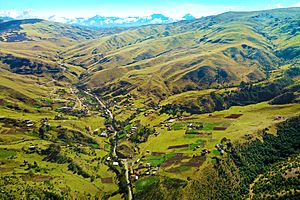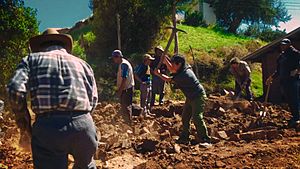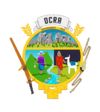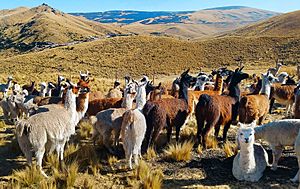Ocra (Peru) facts for kids
Quick facts for kids
Ocra
|
|||
|---|---|---|---|
|
Ayllu (Andean Quechua community)
|
|||

The village of Ocra as seen from the air
|
|||
|
|||
| Country | |||
| Region | |||
| Province | |||
| District | Chinchaypujio District | ||
| Founded | September 7, 1973 | ||
| Elevation | 3,670 m (12,040 ft) | ||
| Population | |||
| • Total | 90 | ||
| Time zone | UTC-5 (PET) | ||
Ocra is a small village in Peru, near the city of Cusco. It is home to a community of Quechua people. The village is very high up, about 3,670 m (12,040 ft) (12,040 feet) above sea level. Its name comes from a plant called okra and an old farm called "Katunki" that used to be there.
Contents
History of Ocra
A long time ago, half of Ocra was a very large farm called "Katunki". The other half was where the farm workers lived. These workers were peasants, meaning they were very poor farmers. They worked for the farm owner, often just to pay rent for their homes. Many of them were in a difficult situation, owing money and living in great poverty.
In the late 1960s, Peru went through big political changes. The government was taken over by a military leader, General Juan Velasco Alvarado, in 1969. He made many changes to the country. One major change was a land reform. This reform took huge amounts of land from wealthy owners. The land was then given to poor farmers across Peru.
As part of this land reform, the "Katunki" farm in Ocra was divided. It became a shared piece of land for the local farmers. This meant the farmers, who were once just workers, now owned the land together.
To make this land ownership legal, Ocra became an official community in 1973. The land was then officially given to this new community. After that, the people of Ocra decided how to share the land among their families. Even today, land is traded, rented, and passed down among community members.
Geography and Environment
Ocra is located in a valley. It is surrounded by rolling hills and interesting rock formations. In the past, many eucalyptus trees were planted here. This was done to help the economy grow.
Now, new eucalyptus trees are not allowed in Ocra. This is because they use a lot of water and can take over other plants. The village is working to bring back native plants. They also want to plant trees that do not use as much water, like pine trees. The local government has helped by planting many pine trees on Ocra's western hills.
A small stream, which flows into the Apurímac River, runs through the middle of Ocra. The hills around Ocra are covered in a type of grass called Peruvian feather grass. This grass is used to feed animals. It is also used to make thatched roofs for buildings, especially storage sheds.
The land in Ocra is very hilly and rough. This makes it impossible to use large farming machines. So, fields are traditionally plowed by people, or sometimes with the help of horses.
Farming and Animals
Ocra is a village where most people are subsistence farmers. This means they grow food mainly for themselves and their families. Farming and herding animals are the main ways people make a living here.
Animals raised in Ocra include llamas and alpacas, which are native to the Andes mountains. People also raise sheep, cattle, chickens, and horses. The places where animals graze are often far from the farms. Shepherds sometimes walk for hours each day to take animals to and from these grazing grounds.
A special animal raised in Ocra is the cuy, also known as a Guinea pig. These are raised as livestock and are cooked as a special food.
Farmers in Ocra grow many different crops. They use small fields, often on slopes. Most of the crops are tubers, which grow underground. These include potatoes, olluco, and maswa (also called añu). About 40 different kinds of potatoes are grown here!
A very important food in Ocra is chuño. These are potatoes that have been freeze-dried. They can be stored for many years. Other crops grown include quinoa, wheat, beans, tarwi, maize (corn), and barley. Not all of these can grow well in Ocra's climate.
Some of the flour from these crops is used to make a sweet breakfast drink. It is similar to oatmeal and sometimes mixed with coffee. A popular local drink is chicha, which is a sweet corn beer.
Culture and Community Life
Ocra's culture is very focused on keeping old traditions and knowledge alive. In 2014, a project from Ocra won an award from CRESPIAL. This award was for "Protecting [its] Intangible Cultural Heritage." It was a big achievement, as it was chosen from 300 projects in 14 countries in Latin America.
The village of Ocra is run by a community council. This council holds weekly meetings where all adults in the village can attend. Most decisions are made by direct vote of the people.
The community also practices something called faena. In the Quechua language, this is known as Mink'a. It is a mandatory weekly community work day. All adults in the village must take part. This idea of working together for the community comes from the Incan times. The local laws in Ocra say that people must do 4 days of faena each month. The community council decides what projects the group will work on.

Faena is like a local tax, but instead of money, people give their time and effort. People in Ocra contribute about one-seventh of their work time to community projects. This is helpful because most people in Ocra are subsistence farmers. They do not always have a lot of extra money. Since they contribute labor, building projects often use local materials like adobe (mud bricks).
Most farmers in Ocra wear a modern version of an old Inca sandal called Ushutas. These new sandals are called Ojota (or Yanquis in Spanish). They are very strong, black sandals made from recycled car tires. People wear Ojotas all year, even when it is very cold. They use them for herding, farming, and building. Even though they are cheap and used a lot on hilly land, they usually last for more than two years.
Tourism and Visitors
Ocra offers special experiences for tourists. These are called "participatory farm stay experiences" or tourismo vivencial. Visitors can stay with local families and learn about their daily life. They can also take day trips, like herding llamas with a local guide. These experiences are offered through groups like the Quechua School and Quechua Trips.
Climate and Weather
Ocra has mild and dry winters, from May to August. The summers, from November to February, are a bit warmer and much wetter. About 162 mm (6.5 inches) of rain falls during the summer. This is typical for the region. While days can be warm, nights often drop below freezing in the winter.
People and Languages
Most people in the Ocra district are indigenous citizens of Quechua descent. The main language spoken is Quechua. About 91.85% of the people learned Quechua as their first language when they were children. Only about 7.95% learned Spanish first, according to the 2007 Peru Census.
Quechua is mostly taught at home. Only some public schools in the area teach it. Because of this, younger generations are learning more and more Spanish.
Images for kids
-
Building a thatched roof with local grass in Ocra during a faena
-
Volunteer learning how to build a hand-made rope out of grass
See also
 In Spanish: Ocra (Perú) para niños
In Spanish: Ocra (Perú) para niños













